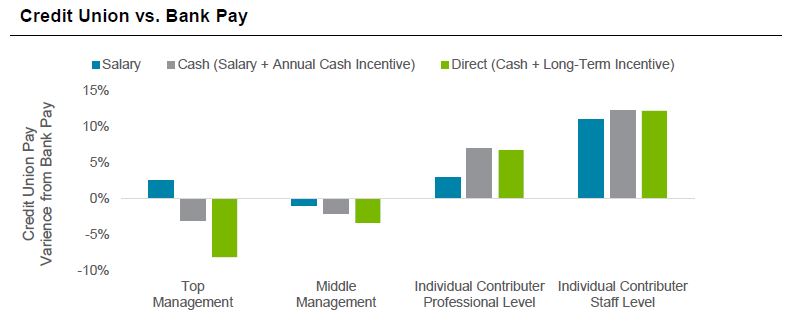What is your credit union’s compensation philosophy? When they’re well thought through, compensation philosophies can help provide an important framework for pay decisions throughout a firm. But far too often, these philosophies are antiquated, and include general phrases like “we strive to provide competitive compensation” and “the goal of our compensation structure is to attract, retain, and motivate.” While few can disagree with these types of platitudes, they are rarely helpful when making actual decisions.
This article focuses on the core questions credit unions should be asking themselves when setting meaningful compensation policies that truly align with their unique business goals.
Why is a more specific compensation philosophy helpful?
The purpose of a compensation philosophy is to help provide a framework for compensation decision making. However, the clichés associated with a standard compensation philosophy typically do not provide an actionable framework for the board of directors when setting CEO compensation, or for human resources when designing salary structures and incentive plans. If your approach to pay is so broad that it doesn’t support decision making or guide strategy, what good is it? As Zig Ziglar once said, “If you aim at nothing, you will hit it every time.” To bring actionable specificity to your philosophy, we recommend discussing two key questions:
- With whom does your credit union compete for talent?
- How does your credit union want to compare?
Question #1: With whom does your credit union compete for talent?
When setting compensation, it is essential to understand who you are competing with for talent. To explore this question further, ask yourself: (1) From where have we sourced our recent hires? (2) To whom are we losing talent? The answers to these questions may vary by level within the organization (executives or entry level) or by function (IT professionals or branch staff). We often hear that credit unions’ biggest competitors are both credit unions and banks. Because of this, credit unions must maintain a strong understanding of pay in both industries. Let’s take a closer look at the main differences between the two.
Comparing credit union and bank compensation
When analyzing both credit union and bank data, it’s important to understand their key differences. The chart below shows how compensation differs by level in the organization at credit unions and banks at approximately $2 billion in assets. These variances can change significantly depending on asset size, especially for management level positions.

There are several distinctions between credit union and bank compensation to note:
- Level: At higher levels in the organization, direct compensation for credit unions (salary, annual cash incentive, and long-term incentive) falls below direct compensation at banks. Individual contributors at credit unions are compensated at higher levels than banks.
- Annual cash incentives: Credit unions pay annual cash incentives to individual contributors more often and at a higher percentage of salary than banks. For management positions, credit unions pay annual cash incentives at a similar prevalence to banks, but actual payouts are lower.
- Long-term incentives: Banks’ long-term incentive vehicle is usually equity and becomes more prevalent for incumbents with salaries over $150,000. Long-term incentives at credit unions are an emerging trend, but still much less prevalent than at banks. When utilized, LTI plans are cash-based and earned based on three to five years of performance goals.
Question #2: How does your credit union want to compare?
Once a competitive market is defined, we recommend specifying how your credit union will ideally compare to that market. At the most basic level, credit unions should determine whether their strategy will focus on meeting, leading, or lagging the market. While many organizations choose to meet the market, commonly defined as the 50th percentile, some firms target the 55th or the 60th percentile due to ambitious growth plans, high expectations or workloads, or the desire to be seen as an employer of choice with competitive pay opportunities. Compensation philosophy decisions should be unique to each credit union’s goals and firm values.
Other questions to consider are the following:
- Should the target market percentile be consistent across the organization, or different based on level or function?
- Should more emphasis be placed on salaries, cash incentives, or a balance of both?
- Should the credit union have long-term incentives in place for executives?
Compensation structures are built around specific market positioning that answers the questions above. While this is crucial to the firm, it is also important to realize that not all employees will be perfectly aligned to the desired positioning. Decision makers have the flexibility to compensate below the desired positioning for new or underperforming staff and above the desired positioning for experienced or high-performing staff.
Next steps for starting the discussion at your firm
So, how can you establish a specific, actionable, and meaningful compensation philosophy at your firm? We’ve summarized a few initial questions below that can help answer the two larger questions discussed in this article.
- With whom does your credit union compete for talent?
- To whom do you lose talent?
- From where do you recruit?
- How does this vary by level or function?
- How does your credit union want to compare?
- Should you lead, lag, or meet the market?
- What should the mix of pay be?
Understanding the answers to these items can help provide a better framework for designing compensation structures, making individual pay decisions, and determining if you are achieving your compensation goals.
Are you interested in digging deeper into compensation philosophies to build out effective pay structures for your firm? Please contact our team—our consultants at McLagan are experienced in working with credit unions, and will provide you with the expertise needed to help set your firm on the right path.
Related Articles